Pulitzer Prize Winning Journalist Walter Pincus is a contributing senior national security columnist at The Cipher Brief. He spent forty years at The Washington Post, writing on topics from nuclear weapons to politics. He is the author of Blown to Hell: America’s Deadly Betrayal of the Marshall Islanders (releasing November 2021)
OPINION — Members of the House and Senate Armed Services Committees want American Presidents to participate, and thus experience, one major military computerized exercise involving the use of nuclear weapons.
Last June, at a Senate Armed Services Strategic Subcommittee hearing, its chairman, Sen. Angus King (I-Maine), announced he was “shocked” when he was told by a committee witness that only one President, Jimmy Carter, ever actually took part in a nuclear weapons drill when they were given an invitation.
The witness was Prof. Sharon K. Weiner of American University, who had worked at Los Alamos National Laboratory, the Joint Staff’s Strategic Plans and Policy Directorate, and the National Security Division of the White House Office of Management and Budget.
She told the panel, “Everybody else sent a delegate – somebody else. And so, you may have the President of the United States in this crisis, the clock is ticking, trying to figure out what to do. Keep in mind there is a huge amount of uncertainty, right. You don’t have perfect intel at that point and so the President is trying to make a decision, and they may never have practiced what it’s been like to be in a nuclear crisis.”
To remedy that situation, the House Armed Services Committee added language to its version of the fiscal 2022 National Defense Authorization Act (NDAA) that requires Presidents “to participate in a large-scale exercise of the nuclear command, control, and communications system during the first year of each term of the President.”
The Senate Armed Services Committee also has language in its version of the fiscal 2022 NDAA that, according to a press release last Wednesday, “Requires involvement from senior civilian and military officials in nuclear command, control, and communications exercises, as well as in the decision-making with respect to optimize Presidential decision capability in a time of crisis.”
The Cipher Brief hosts private briefings with the world’s most experienced national and global security experts. Become a member today.
If some version of that language remains in the fiscal 2022 NDAA that eventually passes Congress and is signed by Biden, starting next year, every President who follows him would have to participate in a nuclear exercise — perhaps by law or through language in the House-Senate conference report.
Presidential participation language is just one of hundreds of provisions members of Congress have added to Defense Department fiscal 2022 budget bills.
At the same time that the House Armed Services Committee wants a President to sit through the exercising of the U.S. nuclear system, it also worries that in the new cyber age, the U.S. nuclear command and control system may not work in response to an adversary nation’s nuclear threat or use of a weapon against U.S. forces or an allied nation.
The House panel has also called for a National Academy of Sciences review of risks to “the current plans, policies, and programs of the nuclear command, control, and communications system, and such plans, policies, and programs that are planned through 2030” for a next generation system.
To meet the potential threat posed by China to a key U.S. air base located in Guam, the House committee also wants the Defense Department to design and construct “a 360-degree integrated air and missile defense capability to defend the people, infrastructure, and territory of Guam from advanced cruise, ballistic, and hypersonic missile threats,” according to the panel’s report on the fiscal 2022 bill. Guam’s Andersen Air Force Base serves as a forward deployment base for U.S. Strategic Command’s nuclear-capable B-52, and B-2 strategic bombers.
Two weeks ago, I described a new nuclear weapons testing program called Enhanced Capabilities for Subcritical Experiments (ECSE). It would allow study of plutonium pits (triggers for thermonuclear weapons) in the underground tunnel complex at the Nevada National Security Site without violating the underground testing moratorium.
Because the program is expected to cost several billion dollars over the next five years, the House committee directed “the Comptroller General of the United States to review the ECSE program, including its adequacy to support the plutonium pit production program and plutonium science programs.”
Go beyond the headlines with expert perspectives on today’s news with The Cipher Brief’s Daily Open-Source Podcast. Listen here or wherever you listen to podcasts.
Back in June, I also suggested the Biden administration take a second look at its fiscal 2022 request for $98.5 million to extend the service of the almost 40-year-old, B83-1 nuclear gravity bombs. It was the last of the megaton weapons that could deliver an explosion equal to one million tons of TNT.
The B83-1 was originally needed as a bunker-buster weapon to destroy underground facilities, but in more recent years a conventional weapon has been designed and used for that job. Newer versions of the B-61 tactical bomb are also capable of the task. Nonetheless, the Trump administration’s 2018 Nuclear Posture Review kept the B83-1 alive after the Obama administration had decided to retire it.
Last week, in its markup of the fiscal 2022 Energy and Water Appropriations Bill, which contains funding of nuclear weapons programs, the House Appropriations Committee eliminated not only money for the B83-1, but also the W80-4, a nuclear warhead for a new, sea-launched cruise missile.
“The Committee considers these proposed investments premature pending the [Biden administration] nuclear posture review,” was the way it was described in the panel’s report on the measure.
Remember back in 2019, when former-President Trump said some American troops would remain in Syria so the U.S. could “keep the oil.” Those troops are still there, but they are protecting that oil so it can be used to help support Kurdish-led and American-backed Syrian democratic forces.
Just to make sure the Trump approach does not happen, the House Appropriations Committee included language in their version of the fiscal 2022 Defense Appropriations Bill “that prohibits the establishment of permanent bases in Iraq or Afghanistan, or United States control over Iraq or Syria oil resources.”
The House Committee bill also contains $3 billion for training and equipping Afghan Security Forces in fiscal 2022. With American forces gone, House members have attached a proviso that the U.S. Defense Secretary must certify that the money is going to an Afghan government “controlled by a civilian, representative government that is committed to protecting human rights and women’s rights and preventing terrorists and terrorist groups from using the territory of Afghanistan to threaten the security of the United States and its allies.”
If that seems hard to accomplish, another proviso is even more difficult. It says $20 million of the $3 billion must be used “to recruit and retain women in the Afghan security forces.”
The Senate Armed Services Committee continued its practice of preventing any President, in this case of the Biden administration, from making any unilateral move to reduce the number of U.S., on-alert, silo-based ICBMs. Its version of the fiscal 2022 NDAA: “Prohibits the obligation or expenditure of fiscal year 2022 funds to reduce deployed U.S. intercontinental ballistic missiles’ responsiveness, alert level, or quantity to fewer than 400.”
It will be months before these bills become law, but there is little doubt that along the way, Members of Congress will continue to try in their own ways to influence the final result.
Read more expert-driven national security insights, perspective and analysis in The Cipher Brief












